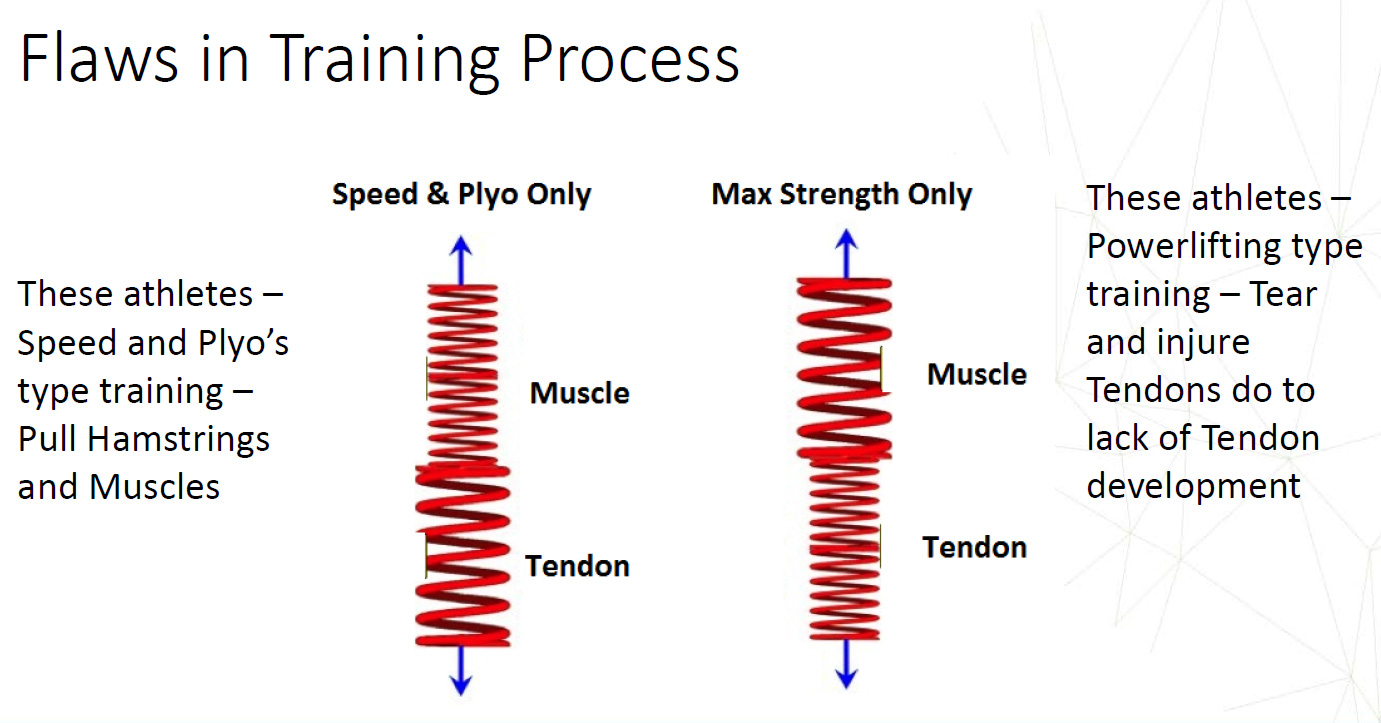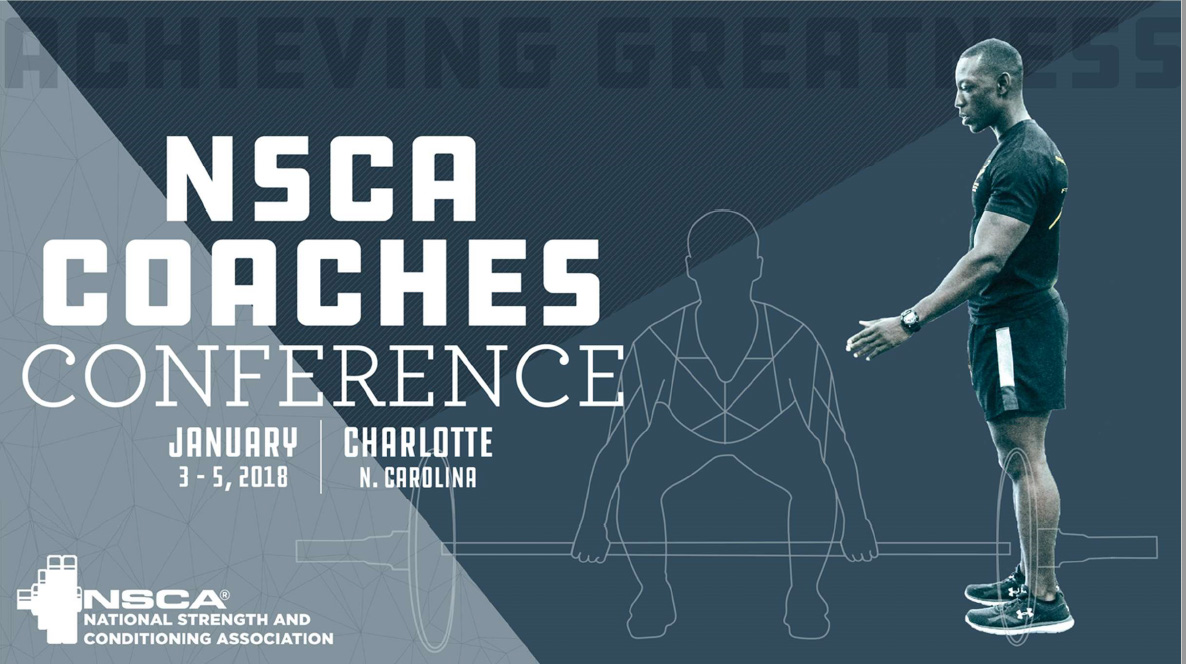 CEU’s
CEU’s
Everyone in the fitness world knows what CEU’s are.
They’re those things that, much like a ninja, creep up on you silently then strike you down.
For the uninitiated:
CEU’s= Continuing Education Units
No matter the certification, you’ll need em to keep it.
CEU’s are:
- Education: so you stay on top of your knowledge and skills and remain active in the community
- Revenue stream: for the certifying agency
The 2015-17 NSCA Recertification Period: AKA My Time of Dying
In the pre kid period, CEU’s were of no consequence.
I always had so many, so early it was just a matter of report them and send the money.
Not So Fast My Friend
Then kids came.
The last CEU period ended Dec 31st 2017 at 11:59pm.
As of Jan 1 2016, I had a grand total of:
ZERO
I got my last ones in on Dec 17th, all 6.0 (60 contact hours).
It was a scramble.
So in an effort to not have that occur again, I went to the 2018 NSCA Coaches Conference in Charlotte NC. <—-2.0 CEU’s
The Short:
It was Really Good…
and COLD
Like crazy cold, record breaking (for that area) cold.
Kinda like last year in Nashville.
So, yeah, the NSCA Coaches Conference brings the terrible, terrible, cold with it.
And next year is in:
INDIANA
….just let that sink in.
But the info, setup and all things important are on point.
Here’s a quick review of the sessions I sat in on (and maybe other goings on):
First things first:
The NSCA “gives” you a shirt for attending, and once again, it’s top-notch.

Back of the shirt
City Smoke has pretty damn good Bar-B-Que
The Westin was a GREAT hotel, the beds are AMAZING.

View from the room
The hotel gym was actually pretty damn good for a hotel gym:
- Lots of open room
- Dumbbells up to 60lbs (that’s 10lbs more than most)
- Peloton bikes
- TRX
- KB’s up to 53lbs
Did I mention it was really cold?
The Sessions:
From the Lab to Your Weight Room- Dr. Bryan Mann
Basically this was a breakdown of some of the more interesting and relevant research that was presented at the 2017 NSCA National Conference (of which I attended as part of the CEU scramble).
Increasing weight, to near limit strength decreases the time the bar is decelerating:
Roethingshoefer, J, Mann, JB, Mayhew, JL, Brechue, WF. Relationship between mean
barbell velocity and %1RM with power for trap bar deadlift and bench press in Division
1 College Hockey players. Poster Presentaiton. Las Vegas, NV. NSCA National
Conference. July 2017.
Heavy weights NECESSITATE you accelerate through the entire lift.
If you’ve ever tried for a TRUE Max/ Near Max lift you know this.
It’s IMPOSSIBLE to lift heavy weights slowly.
You must TRY to accelerate the weight, or you’ll get pinned.
Once Again, Everything in the weight room is Biology and Physics:
F= MA
Force = mass (acceleration)
If the Mass is maximal the acceleration must also be as high as possible to create enough force to overcome the mass.
Being Strong Keeps You Safer and More Resilient:
Maximal strength is the physical quality ALL other qualities are derived from.
All things being equal the stronger you are, the more force you can absorb, the safer you are on the field and the sooner you’ll return to normal functioning following an injury.
Unstable Training IS Useful, Just Not the Way You Think:
We’ve seen that standing on the Bosu ball, is probably a waste if you’re HEALTHY. <—ie, you’re not in a rehabilitation setting.
But what about upper body exercise?
Are these different?
Why?
Not sure, my 2 cents is because the upper extremities operate in an inherently unstable environment, where the lower body is in an inherently stable environment <—-the ground does NOT move.
Long story short adding instability: TO THE IMPLEMENT increases muscle activation, at least in the upper body.
That means, we can use less weight and possibly get a similar training response.
Application(s) for Unstable Upper Body Implements:
- Might be useful during times of injury/ rehab where a lower load can be used to maintain muscle strength/ activation.
- May be useful “In Season” or during a “Deload” to decrease the loads on the CNS.
- Probably can’t produce maximal force, so might not increase limit strength in the very strong or very trained.
Pragmatic Programming: Toward Elite Enhancement- Dr. Brad Deweese
The truly elite are the most difficult to improve, yet the easiest to screw up.
“Your junior high basketball kid is NOT ELITE” – Dr. Deweese
Many sports have the APPEARANCE or being very different but in REALITY they are very similar.
Periodization isn’t a dead concept.
What has changed is the understanding the various ways stressors can be applied to the athlete over time.
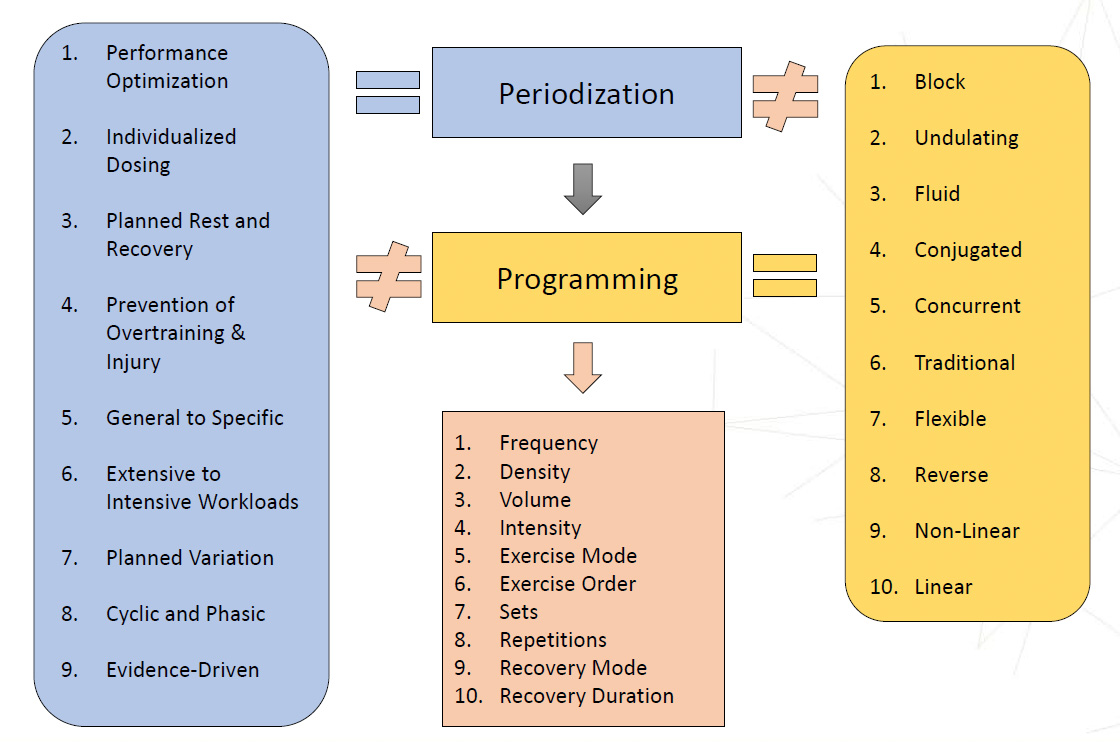
The “Periodization” Slide from Dr. Deweese
The proper application of stressors to achieve a heightened result will always be in vogue.
The ACL Epidemic That Didn’t Need to Happen- Dr. Bryan Mann
ACL injuries can never be completely eliminated.
They can, however be greatly reduced.
Primary mechanisms of Action:
- Hip Adduction
- Hip Internal Rotation
- Tibial Anterior Translation
Other Possible Factors:
- Accumulated fatigue: Most non-c0ntact ACL tears happen early in the game.
- Outside stressors
Primary Factors in ACL Prevention:
Hips:
Valgus collapse (knee moving toward the midline) is THE death knell.
Strong glutes, specifically the deep external rotators.
Key Point: Be Precise and GET OUT OF THE TFL
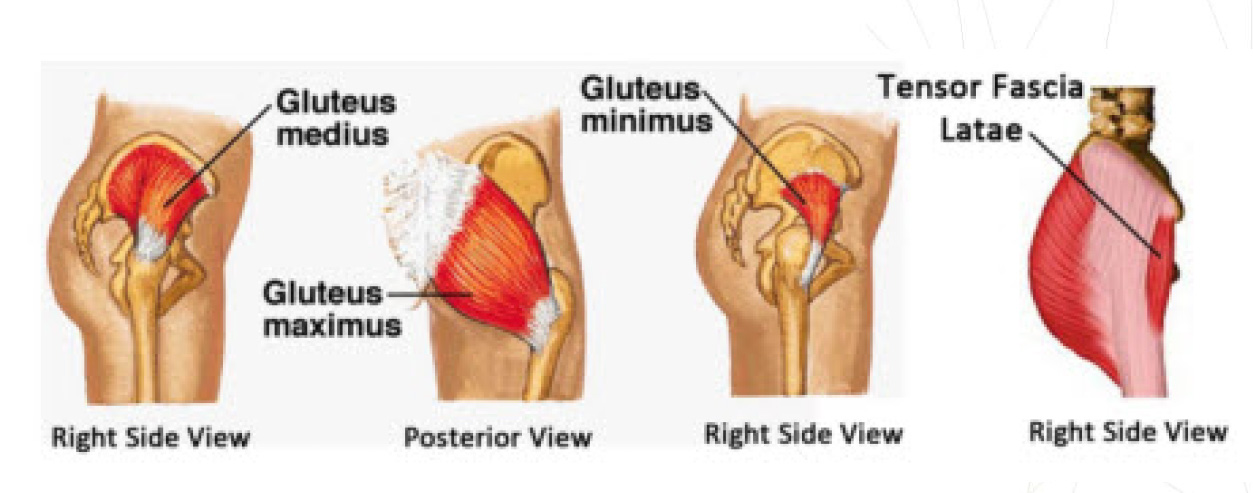
The tensor fascia latate is BOTH an abductor and internal rotator.
The TFL takes over for weak or tired glute medius, strengthening the TFL will only INCREASE your chance of injury.
Hamstrings:
Anterior tibial translation, while less often a culprit, is still a mechanism of action.
Strong hamstrings help keep the femur “back”, from sliding forward, into the kneecap and over the tibia.
Dorsiflexion:
If the ankle can’t flex, you’re going to (k)need more motion up the chain.
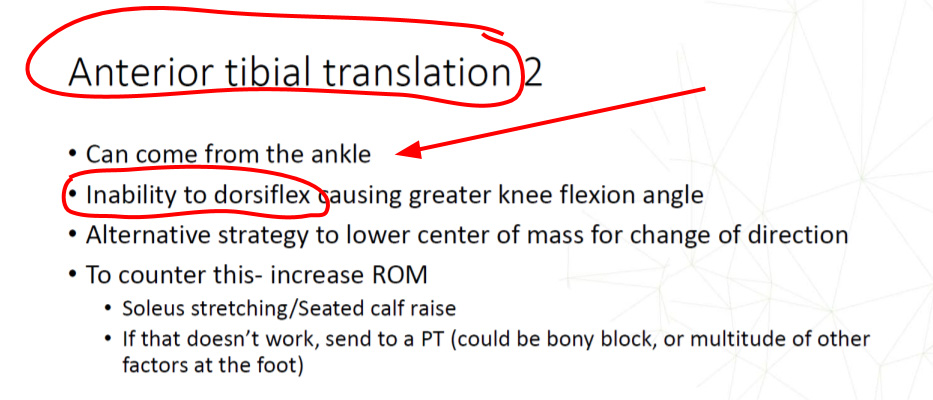 One of Dr. Mann’s slides
One of Dr. Mann’s slides
That will occur at the knee in one of two ways:
- You’re knee will move farther forward over the tibia.
- The foot will collapse and the knee will follow it moving into a valgus position.
Both are the MOA (mechanism of action) for ACL tears.
Most non-contact ACL’s occur EARLY in games, and August is the most “prolific” ACL tear month.
What’s that mean?
ACCUMULATED, not acute, fatigue is a causative factor.
Why?
MUSCLES are producing more force than the ligaments can handle, but we’re tired and using crappy patterns.
How to we Prevent ACL’s?
- Specific Warmups EVERYDAY
- Practice change of direction mechanics EVERYDAY
- Moderate to high level plyos to get the mechanoreceptors going.
- Get STRONG
 Another stolen slide (I don’t think Dr. Mann really cares)
Another stolen slide (I don’t think Dr. Mann really cares)
So You Want to Be a Strength Coach -Joe Kenn
6 Keys to a Prosperous Career:
Things YOU Control #1:
- Your day is created by your Attitude
- BE the example
- Control your actions
Things YOU Control #2:
- PREPERATION
Things YOU Control #3:
- EFFORT
 Things You Manage #4:
Things You Manage #4:
- Understand your role. Be a CHAMELEON
- Law of Niche- MAXIMIZE where YOU add value
- Law of the Catalyst- Get it done….Make things happen.
Things You Manage #5:
- Expectations: Mindful of your goals and circumstances as well as others.
Things You Develop #6:
- Base Fundamentals: Your Why?
- Successful vs. Significant
- Mission: Create a vision then adapt as you experience, learn and situations change
- Who are you? Would you want your kid to be coached by you?
- Teaching: Technical efficiency – Optimal Form, Is it necessary? Just cause we can, should we?
- Methods/ Systems: Keeps your program integrity
- Develop a Culture
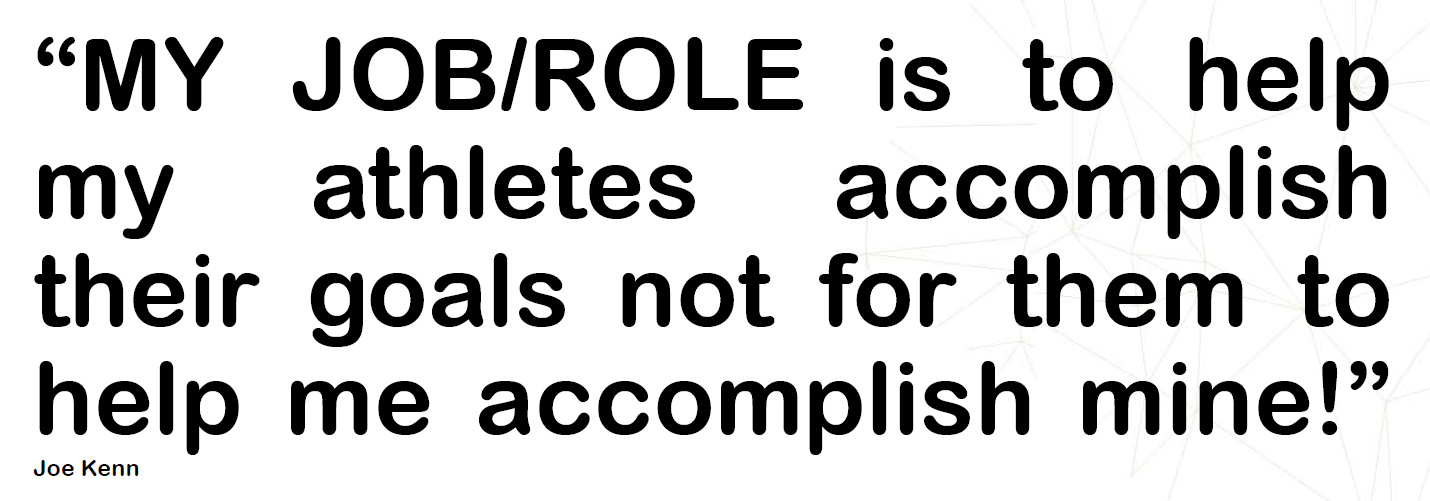 Other Takeaways:
Other Takeaways:
Don’t be a dick…
No one wants to be around a dick and no one respects the dick.
You’ll be King of the Weight Room, but always the last assistant coach.
Quit bitching about waking up at 4:30am and staying until 10pm, find another job.
It’s Ok to be wrong right now (assuming you’re REALLY doing your best) as long as you LEARN, ADAPT, EVOLVE and IMPROVE in the future.
If the YOU right now is no better than the you 5, 3, even 1 year from now, YOU SUCK, you’re not a good coach. #WordsWin
Exertional Rhabdomyolysis- Ben Gleason, PhD
Several factors can contribute to the development of Rhabdo.
- Environment ie heat
- Nutritional Status
- Hydration Status
- Exercise Volume
- Genetics
Take Homes:
Don’t “Redline” you athletes.
There is NO GOOD reason to push your athletes to the point of exhaustion, at least not continually and not without the proper volume and intensity progression to that “Redline”.
The “Navy Seal” workouts, are dumb sh@t that don’t apply to your athletes, they don’t “build mental toughness” and fail to improve performance.
Remember kids: are you getting tired, or better?
No sedentary breaks from training.
Reduced volume and intensity are fine and appropriate, but no breaks.
Don’t just “change things up”…
Adaptations to training are specific so simply changing things drastically can increase your chances of inducing rhabdo.
Long-Term Athlete Development in American Football
– Joe Eisenmann, PhD
The state of youth football Strength and Conditioning is NOT GOOD.
Only 3 in 10 youth football coaches have ANY education in Strength and Conditioning.
Foundational skills have eroded to the point that high school and collegiate strength coaches #1 complaint is that they are consistently getting athletes who have a lack of fundamental movement ability.
We’re not talking 300lbs back squats.
We’re talking, they can’t squat….
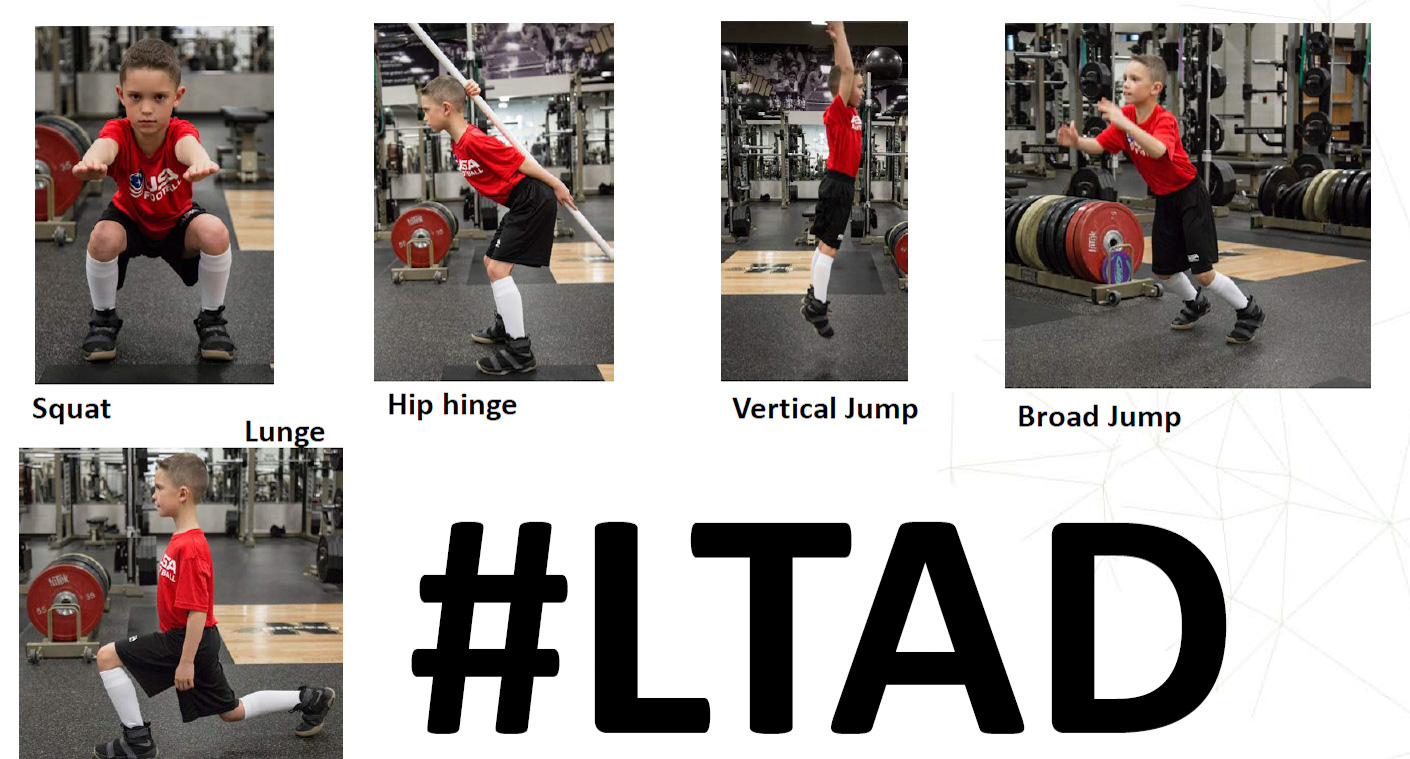
From Joe Eisenmann, Phd
An increasing number of incoming high school and college freshman today can’t perform a single PROPER:
- Squat
- Hip Hinge
- Pushup
Without those skills in place it’s almost impossible to teach good, technically sound fundamentals like sprinting, shuffling and backpedaling.
*Just a thought I had: Maybe some of the safety issues that we’re so concerned about with football have less to do with the inherent dangers of the game but instead the lack of physical competency the athletes have.
Speed and Conditioning for Football- Todd Hamer
“We’re Not Right”, we’re practitioners, not the researchers.
We should defer to the researchers sometimes, because what we’re doing might not be optimal or we’ve misinterpreted previous research and have made application errors.
Energy Systems are the 1st thing that needs to be accounted for and trained.
Interesting Observation:
- The 100M Dash lasts about 9.7- 10 seconds, we’re talking the Olympics here.
- At 6’s the acceleration stops.
- Most goals in hockey are scored in the first 20’s of an offensive shift.
- Most goals are allowed after 35’s on the ice.
- GPS data shows that the length of NHL shifts is decreasing from around 45’s in 2000 to around 35’s in 2017.
Take home:
Fresh athletes are explosive athletes
and when fatigue sets in:
“Bad Things Happen”
Explosive Muscle Actions Can NOT take place past around 6’s, you WILL be slowing down.
The Fastest Team Wins But Conditioning Matters:
It’s great if you can do it once.
It’s really great if you can do it 20 times.
Without the requisite “work capacity” you’ll never recover enough to display your speed repeatedly.
Therefore, even though your sport may be VERY explosive in nature, you’re going to need some longer duration conditioning work to facilitate RSA (repeated sprint ability).
Programming for Training the High School Multi-Sport Athlete
– Cal Dietz
Around 40 identifiable running flaws in high school athletes.
These are never seen in elite athletes because these flaws literally prevent the athlete from being athletic enough to reach elite status.
Key Points:
- Knee pain starts at the hip and ankle, not the knee.
- Hip DRIVES the knee, ankle is the articulation with the ground. The knee is “stuck” with compensating for the deficiencies of those two.
- Pressing the big toe into the ground fires the glutes. <—-Creating a HARD arch in the foot
- Elephants are the ONLY animal in nature that run on their heels.
- Key to running is that the arch never collapses. <—I think I may have seen something about that before.
- Cant run fast if the ankle gives too much, must be stiff and act as a spring when running.
- Knee MUST move in front of the knee to produce maximal sprint force/ speed <——the importance of dorsiflexion
- Foot placement under the body is a hip stability issue.
Stress must be applied to get a training effect.
If there is no DECREASE in performance there wasn’t enough stress applied and therefore will be no training effect.
It’s ok to feel weak and slow as long as its planned for and you get stronger and faster afterwards.
Muscles and Tendons are a 2 Spring Complex:
They must be EQUAL in strength.
All you do is run and plyos?
You’ve only trained the tendon and are at risk for muscle strains.
Only lift weights?
You’ve only trained the muscles and you’re at risk for a tendon injury.
For optimal functioning and performance, you need to do both.
Lift weights to get strong, then do the explosive work to contract those larger stronger muscles faster.
How Much Explosive Work?
The 10% Rule
I first read about this here: Block Periodization by Vladaimir Issurin
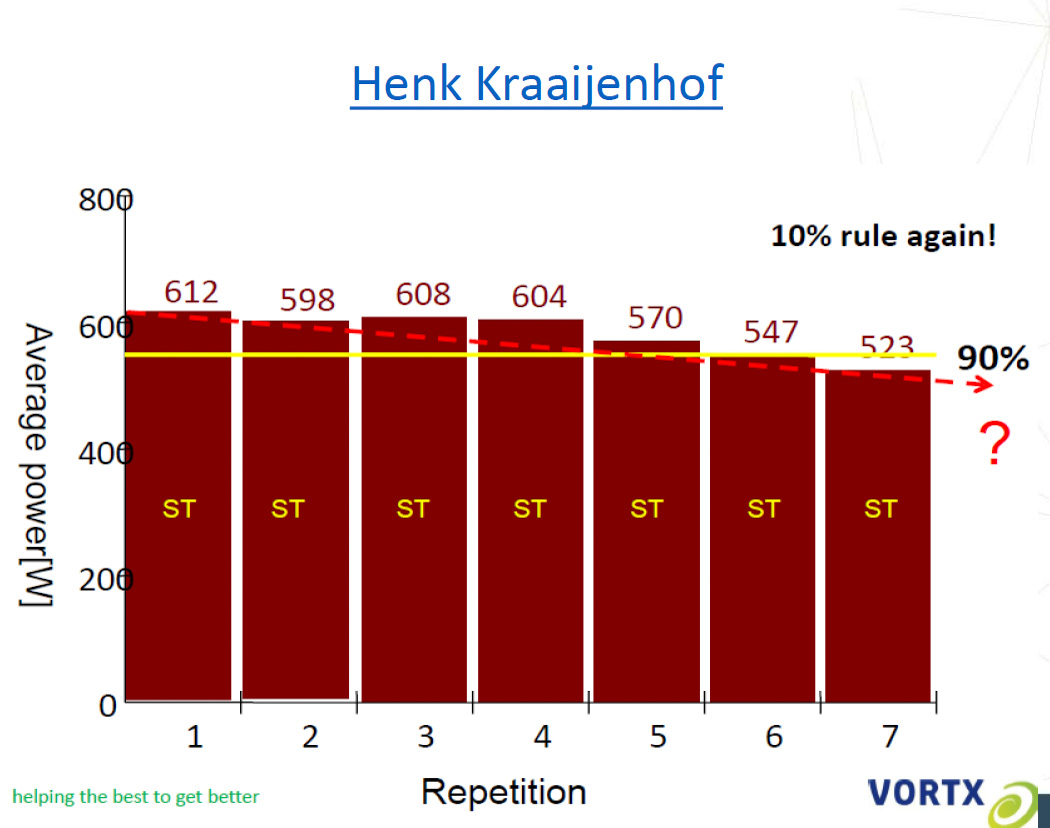
Slide from Cal via Henk Kraaijenhof
Once your reps drop below 90% of your best, you’re no longer training speed.
STOP.
Once you’re performing “explosive” reps below 90% you’re no longer sufficiently targeting the type 2 fibers.
Quality ALWAYS beats Quantity.
Lactate Retention Training:
Instead of flushing lactate accumulate lactate in the system, then do what you can to retain it for up to 1 minute before allowing clearance.
Example;
Run stairs for 45-60’s to accumulate lactate (and other metabolites) in the legs, then immediately squat down to hold the lactate in the legs for another 45-60’s.
This increases the adaptation/ tolerance to lactate and other metabolites.
Lactate Retention Training seems to only work for 2-4 weeks before you’ll see no further adaptations.
How to use and not be USED by Training Technologies- Andy Galpin
Data, data and more data is becoming king, but:

Some major universities have staffs of up to 6 people who are only collecting and “analyzing” data.
But most tracking devices, be it, heart rate, velocity, GPS, are not accurate, at least not always.
The major issue these devices have is that they cannot account for outside variables:
- Environment (hot, cold, wind)
- Competition (hard, easy, tournament with multiple bouts in a day or single bout with days of rest)
- Nutritional status
- Sleep status
“Information and Data are not Coaching Insight”- Andy Galpin
Trackers simply defer to the amount of work done, not the quality.
Fitness Tracking Used Effectively:
Use the tech to VALIDATE and IMPROVE your understanding of how you feel.
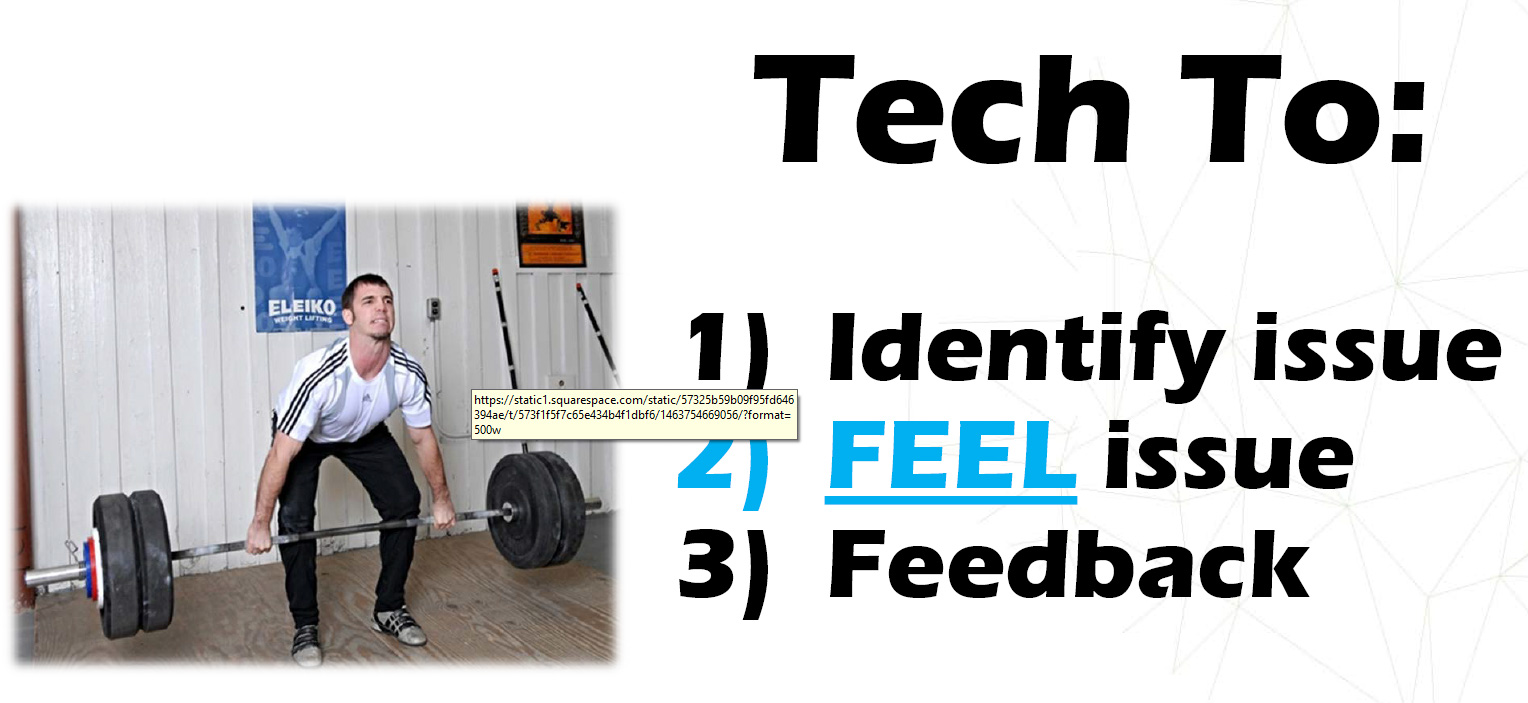
Ultimately tech should:
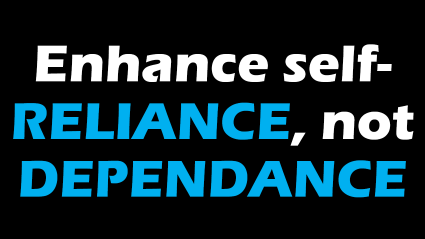
Always Optimizing, Never Adapting:
The primary goal of fitness trackers is to “optimize” training.
However, if the training is always “optimal”, the athlete is never really pushed outside their comfort/ fitness level and adaptation to a higher functional level is never achieved.
*This is again, why you need to lay off the anti-inflammatories.
Inflammation is the 1st step in the recovery process.
Blunt inflammation, blunt the recovery process, blunt the adaptation response

Slide(s) from Andy Galpin <—this site is AWESOME
If You Can “Feel” it, You Can Fix it”- Roy Pumphrey
yeah, I said that.

